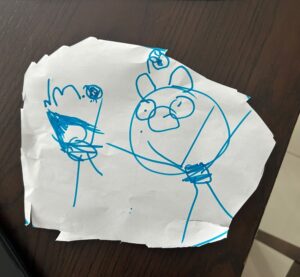Have you noticed that despite all the pencil grips, worksheets, and writing practice…
your child’s handwriting still isn’t improving?
You’re not imagining it.
And it’s not because your child isn’t trying hard enough.
There’s a scientific reason why all that effort isn’t paying off and it has everything to do with how writing skills develop in the brain and body.
Two Approaches to Teaching Writing
There are two fundamentally different ways to support writing:
☝️ Bottom-Up – starts with the foundational systems
👇 Top-Down – focuses on the end goal: handwriting itself
Most schools, therapists, and even some occupational therapists use a Top-Down approach. That looks like:
• Practising handwriting directly
• Correcting letter formation
• Repeating tasks for speed or neatness
• Using tools like pencil grips or worksheets
This approach assumes the brain will “tell” the body what to do and if you just keep practising, the skill will improve.
But here’s the problem:
It skips over all the developmental pieces that actually make writing possible.
What’s Missing: The Developmental Pyramid
Writing isn’t just a cognitive skill.
It’s a complex coordination of multiple systems and it builds in a specific sequence.
At the base of this developmental pyramid is sensory processing. From there, each layer supports the next:
➡ Sensory processing
➡ Core and shoulder strength
➡ Fine motor coordination
➡ Visual motor integration
➡ Only then writing and learning
If the lower layers are shaky or underdeveloped, the top can’t hold steady no matter how much you practice.
This is why writing feels so hard for some kids.
Their brains and bodies aren’t ready yet.
A Different Way: Bottom-Up Support That Works
In my work with children and families, I use a Bottom-Up approach to writing. It’s completely different:
• We start with the body, not the paper
• We focus on how your child processes the world
• We build regulation, strength, and coordination first
• We introduce writing only when the body is ready
• We use play, movement, and sensory-rich activities — not worksheets
And you know what?
It works.
This approach doesn’t just improve handwriting. It supports confidence, attention, regulation, and emotional well-being too.
It’s fun, child-led, and rooted in brain science. And it changes everything.
Want to Learn How?
If traditional methods haven’t worked for your child, it’s not because they can’t learn.
It’s because they need a different approach, one that builds from the bottom up.
In my free workshop, Beyond Pencil Grasp + Q&A, I’ll walk you through:
✅ How to figure out which foundation skills your child needs
✅ Why top-down approaches fail for many kids
✅ Activities that actually support writing (without writing)
✅ How to help your child feel capable, calm, and confident
You’ll get immediate access to the replay, available for one week only.
👉 Click here to register for the workshop
-Munira



